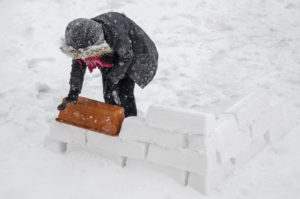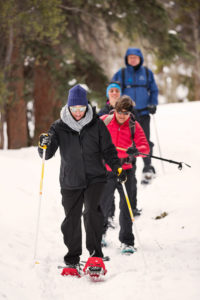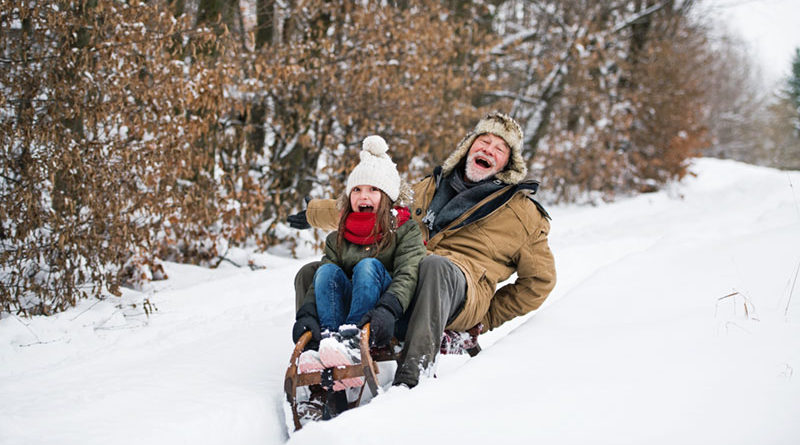A Winter Frolic with Grandkids
By Kimberly Blaker
 If your grandkids are like most, weekends and school snow closings are the highlight of the winter season. Get into the spirit with some of these fun outdoor activities. After you’ve expended your energy outdoors, there’s plenty of fun to be had indoors as well.
If your grandkids are like most, weekends and school snow closings are the highlight of the winter season. Get into the spirit with some of these fun outdoor activities. After you’ve expended your energy outdoors, there’s plenty of fun to be had indoors as well.
Outdoor Winter Frolic
Take a snowshoe hike. Buy or borrow snowshoes for the family, and go on a trek through the woods or a field. Take your compass. But also tie brightly colored strips of fabric to tree branches to mark your path. Dress warm and keep track of time to prevent overtiring and frostbite. Look for animal tracks and burrows; identify trees by the bark and shape of their trunks; learn how to tell the time or direction by the position of the sun; and other nature and survival activities.
Visit an ice sculpture show. Look for these captivating displays on college campuses, in city parks, and indoor arenas. Check with your local and nearby chamber of commerce or state travel bureau for events listings.
Visit a zoo. During the winter months, zoos often bring guest animals and offer special exhibits. Arctic and cold climate animals may be more active, and indoor exhibits are easier to view because of smaller crowds.
Build an igloo or snow fort. Choose a day when the snow is suitable for packing. Use a square or rectangular container for building snow forts, which are often found in toy departments. Be sure to stagger the blocks for support.
Take a winter carriage ride. Look for horse-drawn carriages in tourist or trendy towns and quaint villages. Bundle up, and take warm blankets and hot beverages. Then enjoy a cozy ride through a snowy, festive town.
Enjoy a winter fest. Visit your chamber of commerce or state travel bureau website for a list of winter festivals and events. Activities to look for include light displays, fireworks, winter sports competitions, recreational activities, exhibits and ice sculpture displays, sleigh rides, snowshoe tours, and more.
Have a snow-sculpting contest, and invite your neighbors to participate. Roll a snowball as large as you can. Then fill buckets with snow and carefully dump them on top. Gently pack the snow and smooth it with your mittens. Sculpt and shape your creation using small shovels and gardening tools. When your sculpture is complete, gently pack and smooth it with your hands again.
Make an ice tree. Instead of throwing out your holiday tree, turn it into a winter display. Stand it in your yard, turn the water hose on low, and spray upward and toward the trunk of the tree. As ice forms, continue spraying until you achieve your desired effect.
Go sledding. If you have small hills in your backyard, use a trash bag for sliding down them. Better yet, head to some real hills with your toboggan or sled. Keep safety rules in mind for safe wintery fun.
Indoor Activities For Blustery Days
 Head to a museum. Most cities, even small towns, have a historical museum. Hands-on science, art, or natural history museums are found in most metropolitan areas or at nearby universities.
Head to a museum. Most cities, even small towns, have a historical museum. Hands-on science, art, or natural history museums are found in most metropolitan areas or at nearby universities.
Grab your roller blades or skates and head to your nearby indoor rink. These arenas are updated for today’s kids and are a blast for grandparents and kids alike. If you’ve never roller-skated, take a class at the rink.
Create an indoor snow family. Buy black and white clay from an arts and crafts supply. Roll snow people out of the white clay, and shape hats with the black. Make arms with tiny twigs, scarves from narrow fabric strips, eyes and buttons from whole pepper, and noses from broken orange-colored toothpicks.
Tour a manufacturing plant. Tours are often available to the public even if they aren’t well-publicized. Just call to find out.
View the winter sky. Visit a planetarium to see constellations and some of the brightest stars of the year.
Hold a winter movie fest. Invite friends over, rent a selection of movies, and have everyone bring their pillows or beanbag chairs. Don’t forget the buttery popcorn and hot chocolate. If you’ve had enough of winter, hold a Hawaiian luau instead. Choose summery or vacation-themed movies. Serve cold drinks with little umbrellas and fruit on top. And don’t forget the beach towels.
Make up funny skits with friends then put on a show for grandparents, parents, and neighbors. Choose household products and create silly advertisements. Make up goofy songs or poems about each product and dress up for the part. Be sure to videotape the skits for hilarious family memories.
Put together a winter emergency kit. Include spare hats, mittens, scarves, and boots, a flashlight, and other items in case you get stranded. Your home kit should include items for a snow-in or power loss. Have everyone work together to create a list and gather items for the kits.
String a snowflake streamer. Make snowflakes by folding white paper several times and then trimming different shapes around the edges. Open the snowflakes then string them on a piece of yarn, and hang it across the room.
Visit the library to snuggle up for a relaxing read. When you arrive, learn how and where to find books on your interests such as sports, science, or a hobby. Then choose several books to bring home. Don’t forget to check out music CDs, audiobooks, videos, computer games, and magazines for plenty of indoor entertainment.
Getaway at a weekend resort. check your travel agency for one of the many winter resorts for outdoor enthusiasts that offer activities and accommodations for the whole family. Try downhill or cross-country skiing, snowshoe excursions, and more.
Make a winter-safety trivia game. Buy a pack of small index cards. Then write a question on each card related to winter safety with the answers written below. To play the game, take turns reading the questions while other players shout their answers. The first person with the correct answer scores a point.
Grandma Isn’t So Lonely After All
Even though older adults may have smaller social networks than younger adults, they have similar numbers of close friends and levels of well-being, a new study finds.
“Stereotypes of aging tend to paint older adults in many cultures as sad and lonely,” said study lead author Wandi Bruine de Bruin, of the University of Leeds in England.
“But the research shows that older adults’ smaller networks didn’t undermine social satisfaction and well-being. In fact, older adults tend to report better well-being than younger adults,” she added.
The researchers analyzed data from nearly 600 adults who took part in two U.S.-wide online surveys. The participants provided information on the number of people they’d had regular contact with in the past six months. Contact included face-to-face, by phone or email or online.
Participants were also asked to rate their feelings of well-being over the past 30 days.
While older adults had smaller social networks than younger adults, the number of close friends was unrelated to age. Younger adults had large social networks consisting of mostly “peripheral others,” such as coworkers, school or childhood acquaintances, and people who provide a service.
This may be because online social media sites have led to large and impersonal social networks, according to the authors.
They found that only the number of close friends was associated with social satisfaction and well-being among adults of all ages, even after the number of family members, neighbors and peripheral others was taken into account.
“Loneliness has less to do with the number of friends you have, and more to do with how you feel about your friends,” Bruine de Bruin said in a journal news release. “It’s often the younger adults who admit to having negative perceptions of their friends. Loneliness occurs in people of all ages. If you feel lonely, it may be more helpful to make a positive connection with a friend than to try and seek out new people to meet.”

